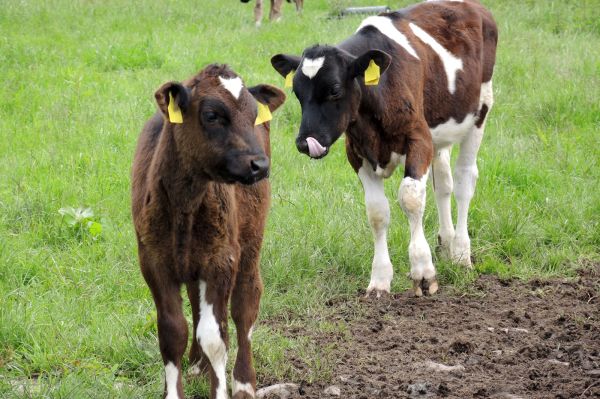Beefing up performance

Teagasc is engaged in intensive research around the optimum management practices to reduce costs, increase performance and, ultimately, deliver profitability on dairy-beef cattle farms. The organisation delivered an update on its dairy-beef rearing research at a recent beef conference attended by over 400 cattle farmers.
At Johnstown Castle there are impressive trials going on around pasture management, sward types, inputs and animal management which are showing that moving from traditional practices can deliver significant improvements in margins. Initial results from the trials were highlighted at the Teagasc National Beef Conference last November.
Comparing swards
Dr Ellen Fitzpatrick is engaged with her colleagues at Johnstown in comparing sward types to identify productivity improvements. An overall policy ambition from the research trials is to reduce slaughter age on average by three months and to reduce chemical nitrogen use by 20 per cent. In the background are the aims of lowering greenhouse gas emissions as well as potential nitrates leaching. Ultimately, if these aims are achieved, there is a commercial advantage around lower cost beef production. Incorporating legumes and herbs into pasture reduces the requirement for chemical fertiliser nitrogen and concentrate supplementation in grass-based dairy-beef heifer systems. The positives extend beyond age and carcass weight improvements, with lower costs also achieved.
In the trials, dairy-beef heifers are consuming herbage from perennial ryegrass (PRG)-only swards, PRG + clover swards, and multispecies swards (MSS). The results show significant variations between the three sward types, with carcass weights of 243kg, 250kg and 249kg, at 19.6 months, 19.2 months, and 19.2 months of age, respectively. Being able to achieve a seven kilogramme increase in carcass weight at the same or lower slaughter age can be the difference between a mediocre and a decent return for the enterprise. Similar herbage production was achieved for all three pasture types, despite a 75kg/hectare reduction in annual chemical nitrogen application to the clover and MSS treatments.
The trials were standardised across the three systems, though with important variations in inputs. Nitrogen (N) use, for instance, varied from 150kg N per hectare for the perennial ryegrass swards, to 75kg used on the clover (red and white)/ryegrass swards and 75kg/ha also applied to the MSS.

Tables and graph supplied by Teagasc.
Animal performance
The crossbred calves were bought in at 20 weeks of age, averaging 159kg bodyweight. Angus and Hereford crosses were the chosen breeds. Initial pasture covers for all three swards was 1,300-1,600kg/ha with a 48-hour rotation operated. Post-grazing height was also standardised at 5cm. In the first year at pasture, significant performance differences were noted, with the calves on MSS and clover/grass swards outperforming the calves on grass swards. Overwintering performances were on a par, whether the silage was grass or other based. At slaughter, animals with body condition score at or over 3.75 were drafted, with most coming off grazing for slaughter and any not ready being finished indoors, boosted with 4kg of concentrate. The benefits of slaughtering off grass are clear, with indoor finishing costs minimised or avoided entirely.
Ultimately, the biggest outcome was the higher performance of animals grazed on clover-mix and MSS. The list of positive outcomes is impressive and should form the basis for a long-term approach to cost-effective dairy-beef enterprises. Improved animal performance, reduced age at slaughter and reduced fertiliser inputs all combine to deliver increased profitability.
Further research ongoing
A new study at Johnstown, initiated in spring 2023, was confirmed by Dr Fitzpatrick. It involves several variations on the theme of trialling performance around different sward types. The new trial is using the three pasture types, two separate maturity protocols and three slaughter ages. The reality is that Angus and Herefords will achieve a reasonable kill-out at younger ages and at lower carcass weights than heavier beef breeds. This trial around the potential performance of later maturing breeds, namely Limousin and Belgian Blue in this instance, should provide guidelines for farmers with those breeds in their dairy-beef enterprises. Slaughter ages will vary across 16, 19 and 22 months.
While the main performance outcomes from the Johnstown castle trials are the most important, there were other notable observations that may prove somewhat significant over time. Dry matter in the multi-species swards was significantly lower on average, than in the grass only and grass-clover swards. That did not prevent comparable and even improved thrive from the MSS, even though that might have been an expectation, as higher dry matter would suggest higher intake potential and digestibility, presuming nutrient values are comparable.
There are some question marks over sward persistence in MSS. Changes in pasture management practices could reduce that challenge somewhat, but there may be higher re-establishment costs in the longer term, as essential species decline in the swards. Chicory and plantain, in particular, are important components in MSS. The absence of clear protocols for long term management of MSS is also a concern. Weed infestation must be controlled, no matter what the pasture composition. Sward replacement is a high-cost exercise and must be a consideration in the long term production cost structure for both animal and sward performance. Teagasc does seem to recognise these challenges and is exploring options to at least minimise the potential costs involved.




